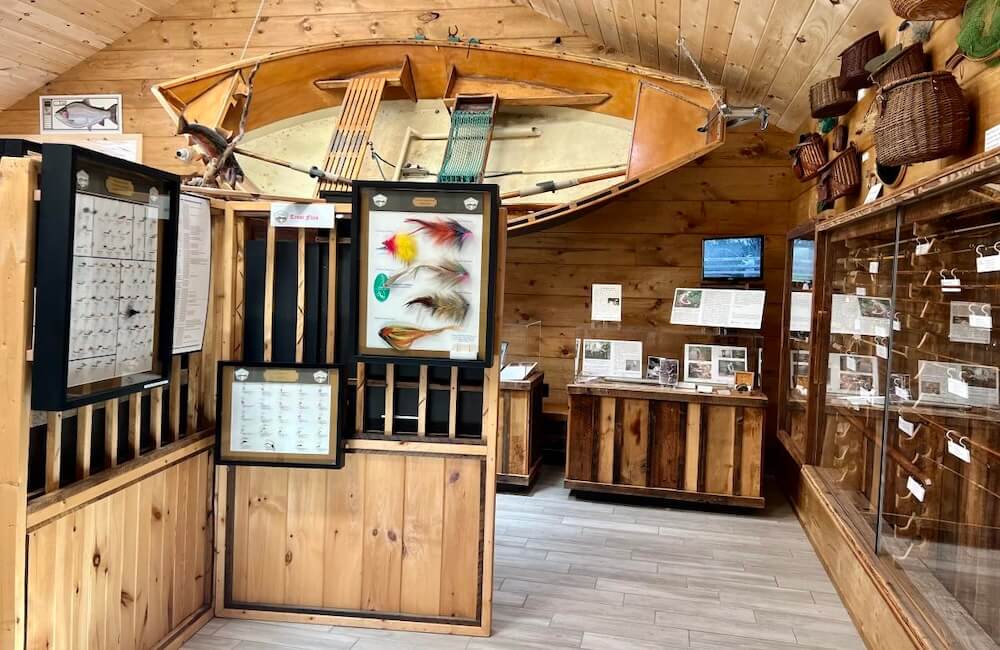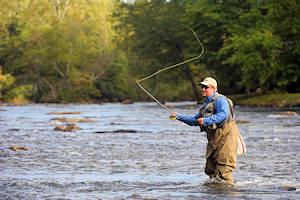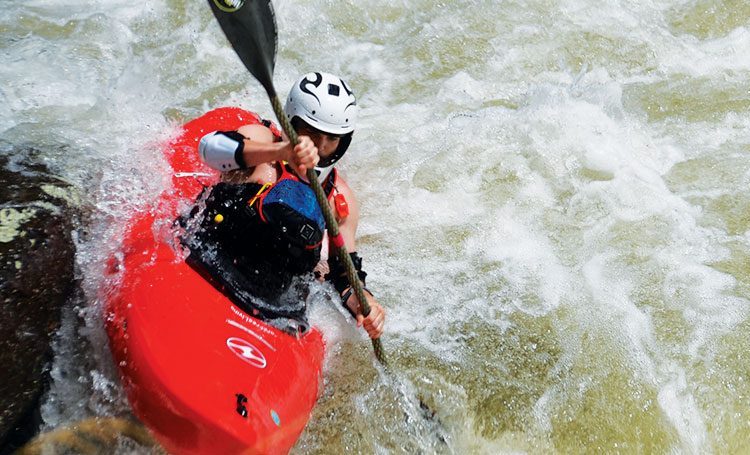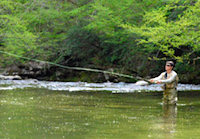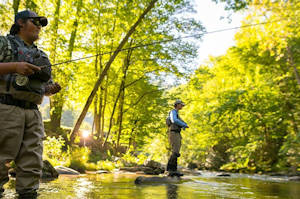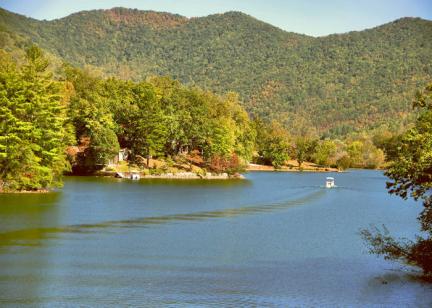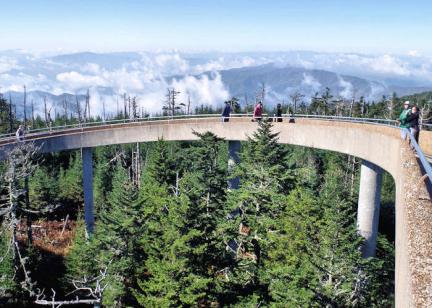Win a Downtown Asheville Stay + VIP Event Tickets
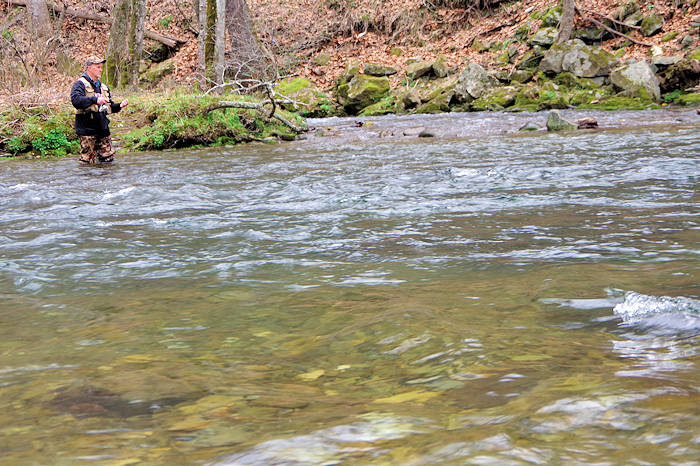
With almost 3,000 miles of streams and rivers within the Great Smoky Mountains National Park, you'll find a big variety of fishing experiences from remote headwater trout streams to large cool-water rivers. On our North Carolina side of the Smokies near Asheville, fly fish in pristine creeks or rent a boat to fish lakes inside the park and the nearby communities, including Cherokee, Sylva and Bryson City. New to fishing? Find plenty of guided fishing trips with locals who know the best spots and will teach you many angler skills to take home. Heads up: Fishing regulations vary depending on your exact location - inside the national park or just outside park boundaries.
Tips for Great Smoky Mountains National Park Fishing
Fish year-round inside the park, allowed 30 minutes before sunrise to 30 minutes after sunset. While you can fish in most streams, some are closed to protect threatened species. Stop by a visitor center (including Oconaluftee) or ranger station for updated, detailed information including a list of regulations and a map of fishable park waters. Here are some details and tips:
- A valid fishing license or permit from or Tennessee or North Carolina is required for ages 16 and older - either state license is valid throughout the park. Fishing licenses and permits are not available in the park but may be purchased in nearby towns.
- Special tribal permits are required for fishing in Cherokee (read more below). If fishing in adjacent Nantahala National Park, be sure to have a NC Fishing License.
- Daily limits are five brook, rainbow or brown trout, smallmouth bass, or a combination of these. 20 rock bass may be kept in addition to the above limit.
- Size limits are 7 inch minimum for brook, rainbow, brown trout and smallmouth bass.
- Fishing is permitted with one hand-held rod with artificial flies or lures with a single hook. No live bait allowed.
- Standing and wading in streams can drain body heat and lead to hypothermia. Most of the water originates from high in the mountains, so it can be frigid even in summer months. Rising water levels can result from sudden storms especially in summer months.
- Water currents are swifter than they appear and footing is treacherous on wet and moss covered rocks.
- It is unlawful to dispose of fish remains on land or water within 200 feet of a campsite. It's bear country!
- Disturbing and moving rocks to form channels and rock dams is illegal. Moving rocks is harmful to both fish and aquatic insects that live in the streams.
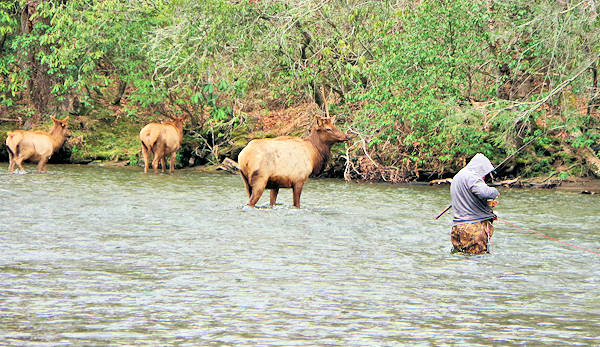
Fishing on the Oconaluftee: Don't be surprised if a few elk visit. They are very accustomed to humans, so don't be alarmed.
Places to Fish in the Great Smoky Mountains Area
- The Oconaluftee River is a very scenic freestone river with headwaters (Beech Flats Prong) near Newfound Gap at 5,048 feet. As it flows down and grows as other tributaries join the journey, the river follows along Newfound Gap Road (US 441). In the lower elevations as you approach the Cherokee area, find plenty of roadside spots for river access - including the Smokemont Campground Area and the Oconaluftee Visitor Center. Nearby, it flows underneath the terminus of Blue Ridge Parkway and continues into the Qualla Boundary of the Cherokee Indians (read below).
- Deep Creek (enter the Park from Bryson City) is a large freestone creek known for its brown trout. Find rainbow trout in lower sections and Southern Appalachian strain brook trout higher. Deep Creek Trail, which runs 15.9 miles from the trailhead, offers easy access to the water. In the summer, the first mile of Deep Creek is very popular for tubing. So expect crowds there, but find very few people farther up the trail. Indian Creek flows into Deep Creek with best fishing beyond Indian Creek Falls. Read more.
- Speaking of Bryson City, you can fish in the middle of town on the Tuckasegee River. While you are there, check out the Southern Appalachian Museum of Fly Fishing. Go to the Swain County Fishing Guide.
- Fontana Lake is the fourth deepest man-made lake in the country. Because of that, its colder water is home to many species of fish typically associated with cold northern lakes. It has 238 miles of shoreline, with about half the shoreline within the National Park. There are many coves and islands, so getting a local guide will certainly help you to navigate. Find public piers and boat rentals too.
- In Jackson County, on the east side of Cherokee, find the Western North Carolina Fly Fishing Trail with 15 top spots for catching brook, brown and rainbow trout along the Tuckasegee River. Go to their Website.
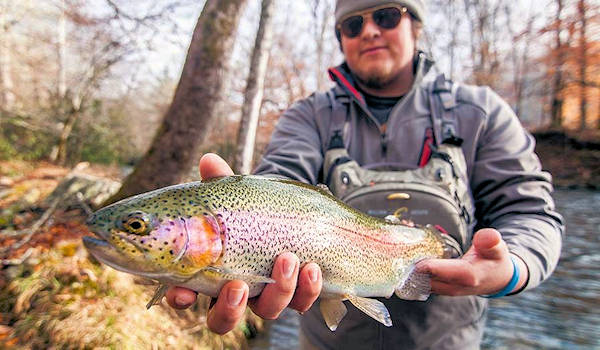
Fishing on the Cherokee Indian Reservation
Qualla Boundary, home of the Eastern Band of Cherokee Indians, is a sovereign nation located within the borders of the United States. So anyone age 12 and over must have purchase a tribal permit to fish on their property that is adjacent to the national park land. They heavily stock their waters (400,000 trout each year) and welcome all to fish their many miles of streams. Purchase a permit online or one of many shops in town.
The Eastern Band of Cherokee Indians’ Enterprise Waters, overseen by Fisheries & Wildlife Management, consists of 30 miles of freestone streams connected to one another. Fish in secluded forest settings, suburban roadside areas and even the center of the town of Cherokee in the Oconaluftee Island Park (especially nice for families). Fishing is allowed from one hour before sunrise to one hour after sunset. The daily limit is ten fish per day per permit holder.
Where to fish in Cherokee? Soco Creek is the smallest and most wade-able of the stocked waters. Raven Fork is one of the larger stream systems, which is very pretty and well known, and with easy drive-up access. The Parkway Haven is a portion set aside for catch-and-release fishing, offering deep inviting pools, riffles, runs, and pocket waters. Oconaluftee River, running from the National Park through town, is the biggest river with the greatest diversity of fish. See our Cherokee Guide for more.
Go to our Great Smoky Mountains Outdoors Guide for many more things to do during your fishing vacation.
Great Smoky Mountains Fishing Resources
Fly Fishing Museum of the Southern Appalachians
Through exhibits and videos, learn about past fly fishing legends, the evolution of rods and reels, basic knots, fly-tying, types of gear, types of gamefish, regional fishing waters and the… read more
Through exhibits and videos, learn about past fly fishing legends, the evolution of rods and reels, basic knots, fly-tying, types of gear, types of gamefish, regional fishing waters and the history of fly fishing in the Southeast. Open Mon-Sat. Free admission. Check out their Facebook page for hours and updates. 117 Island St., Bryson City, NC 28713 on the Aquarium Campus
WNC Fly Fishing Trail®️
Welcome to the first and only fly fishing trail in the United States with the best 15 spots for catching brook, brown, and rainbow trout. With 92,800 fish stocked in its waters annually, Jackson… read more
Welcome to the first and only fly fishing trail in the United States with the best 15 spots for catching brook, brown, and rainbow trout. With 92,800 fish stocked in its waters annually, Jackson County was named NC Trout Capital ®️. See detailed maps and fishing reports.
Great Smoky Mountains NC Travel Guide
Order the free 115-page Great Smoky Mountains North Carolina Travel Guide that includes activities and adventures in seven counties that surround the national park, published by Smoky Mountain… read more
Order the free 115-page Great Smoky Mountains North Carolina Travel Guide that includes activities and adventures in seven counties that surround the national park, published by Smoky Mountain Host.
Smoky Mountain Host Blueways
Find plenty of watersports and adventures in the most visited outdoor recreation area in the Southeast with five major rivers and four lakes with pristine waters for fishing, boating,… read more
Find plenty of watersports and adventures in the most visited outdoor recreation area in the Southeast with five major rivers and four lakes with pristine waters for fishing, boating, whitewater rafting, and more in the Great Smoky Mountains, Nantahala Forest, Pisgah Forest.
Fishing in the Smokies, Bryson City
Discover one of the most diverse fishing habitats in the world with four rivers and dozens of mountain streams throughout the Great Smoky Mountains, and the deep, cold waters of Fontana Lake. You… read more
Discover one of the most diverse fishing habitats in the world with four rivers and dozens of mountain streams throughout the Great Smoky Mountains, and the deep, cold waters of Fontana Lake. You can even fish the Tuck in downtown Bryson City. Greatly enhance your chances of catching trophy fish by hiring a professional fishing guide. Find 26 best fishing spots and guide services.
Fishing in Cherokee
Find an abundantly trout-filled stream system in Cherokee with 30 miles of freestone streams that include secluded forest settings, suburban roadside areas, and even the Cherokee town center.
Find an abundantly trout-filled stream system in Cherokee with 30 miles of freestone streams that include secluded forest settings, suburban roadside areas, and even the Cherokee town center.
